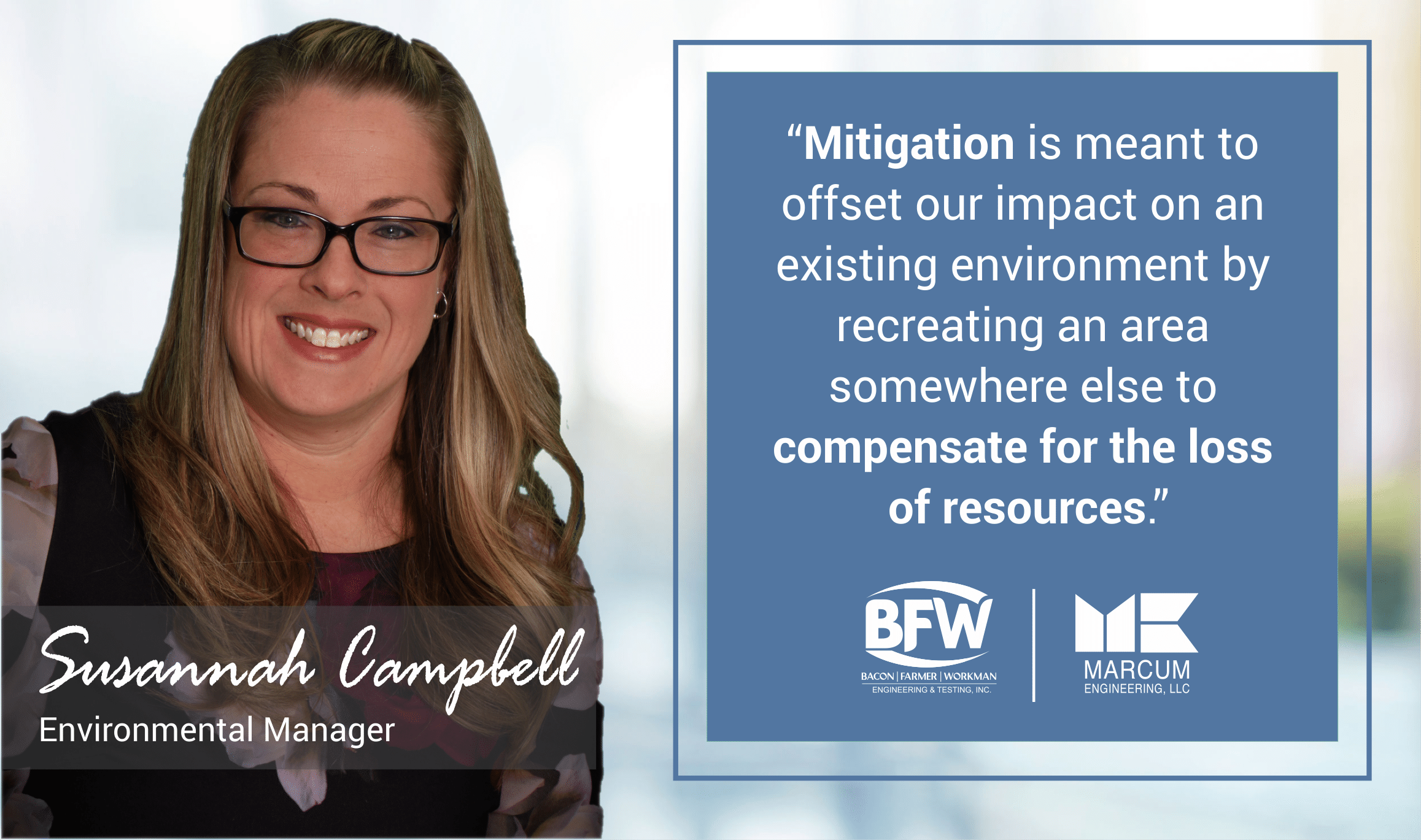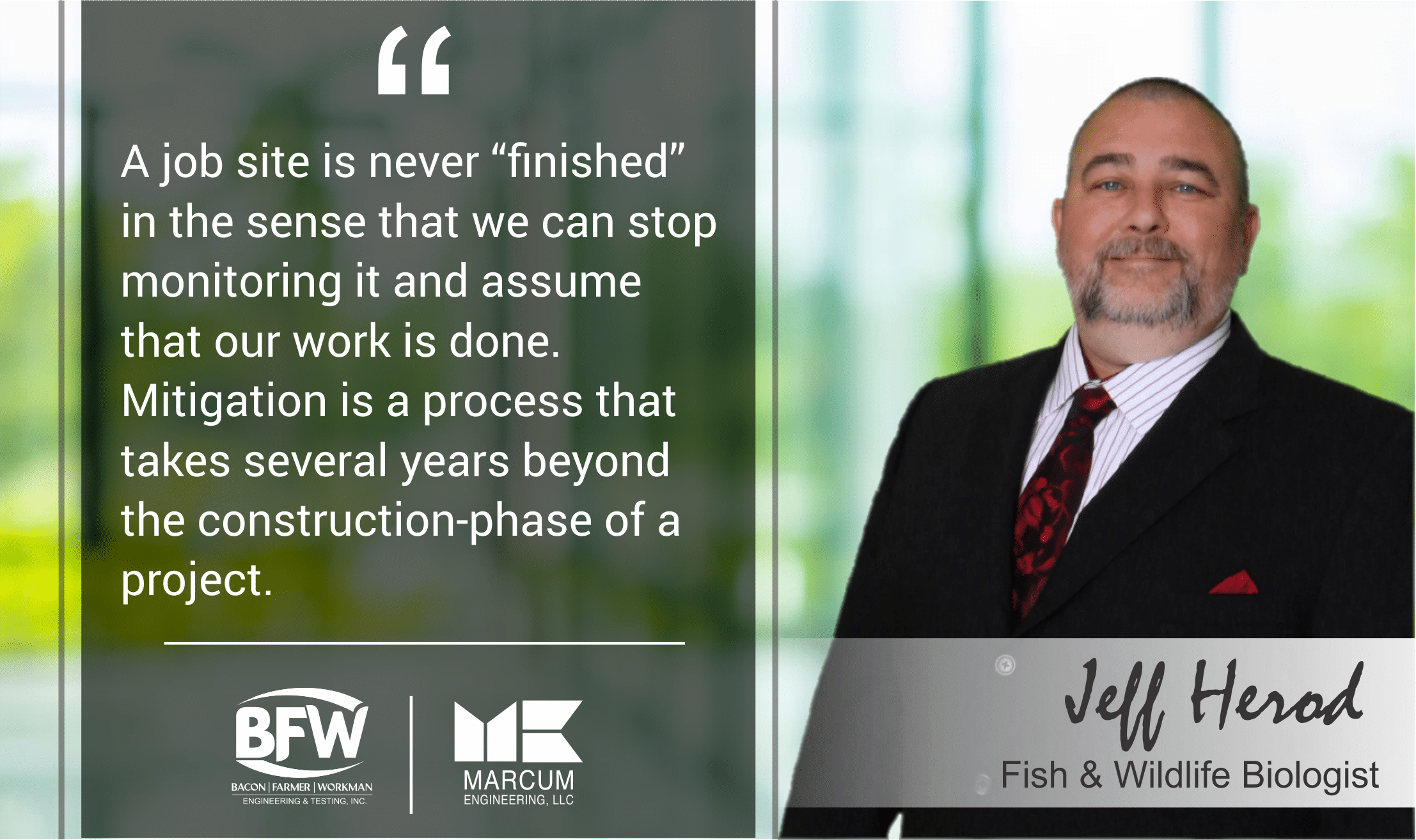Transportation & the Environment: Mitigation
Both our Environmental Manager, Susannah Campbell, and our Fish & Wildlife Biologist, Jeff Herod agree; when it comes to construction, it’s always ideal to completely avoid interacting with sensitive areas and species in the environment entirely. To put it simply: let well enough alone.
However, sometimes that approach is impossible, especially in transportation engineering. We often have few options when it comes to the ideal placement of our public transportation infrastructure. At the end of the day, sometimes you are left with choosing the lesser of two evils. Yet, when an sensitive area is in danger of being affected by a job, there is still a detailed process that can avoid damaging the delicate natural system already in place. In engineering, we call this process “mitigation”.
Avoid it Until You Can’t
Our firm isn’t known for avoiding things; we like to face challenges head-on. However, when it comes to our interactions with local wetland or endangered species habitats, we’re proponents of avoiding them at all costs. If there is a way to re-route a project so it averts a particular stretch of wetland, then let’s crunch the numbers on that option and explain to the client why it’s the better choice. Jeff understands this well, but also understands when avoidance isn’t possible.
“The first option is to always avoid a sensitive area, where possible. However, when that’s not probable we rely on mitigation as the next-best option.”

By its very definition, mitigation is meant to offset our impact on an existing environment by recreating an area somewhere else to compensate for the loss of resources. In cases where it’s affected, it then falls upon us to either replace it, transport it, or equalize our impact in some other way. Many of these processes are strictly controlled by the regulatory agencies which could include US Fish and Wildlife, US Army Corps of Engineers, etc.
Furthermore, state departments have stringent regulations that we must both understand and follow. All of this serves to ensure that the newest Kentucky interstate widening project isn’t inadvertently cutting into a waterway that houses an endangered species of mussel, for instance.
We Do It Right the First Time Every Time
As the Environmental Manager for the firm, Susannah has plenty of experience working with these agencies and departments to ensure we do things right. “DOT has strict regulations that outline the specifics for what qualifications a firm must have in order to do work with the state.”
They require a lot of documentation, which lists the specifications an engineering firm must have to be considered for work. Preparing a proposal is expensive and takes a lot of preparation time. Presentation of the requirements is key in winning the proposals and takes a lot of effort to compete with other larger firms that may have been doing this work already.”
To put it simply, you need to come to these departments with a plan and an ability to execute. You can’t play things by ear; you need to be a firm that is fine-tuned and familiar with working with plenty of departmental oversight. Luckily, we’ve been doing this a while. We’re proponents of challenging standards; they keep everyone working at 100%.
Our Work Serves the Community, the Environment, & Our Expertise
Susannah is one of our biggest campaigners when it comes to working with regional departments, especially in an era when the environment is at the forefront. “It’s my job to determine what environmental work BFW will go after and what will be the most profitable for the firm. Performing local government work has aided in developing our firm’s expertise and provided experience for Department of Transportation (DOT) work.
The BFW/Marcum environmental team has a long list of skills that allow our firm to cover many environmental issues in-house. Our team has a lot of federal and governmental experience which allows us to perform the work efficiently and provide the appropriate oversight to get the work completed on time.”
When you do things right and with purpose, every action you take serves the bigger picture. Community, environment, expertise; they all work to support each other.
Mitigation Doesn’t Stop When the Last Crew Member Leaves
Jeff wanted to make one thing clear: the process of mitigation is continuous. A job site is never “finished” in the sense that we can stop monitoring it and assume that our work is done. Mitigation is a process that takes several years beyond the construction-phase of a project.

“I have one example I can give that’s fresh in my mind.” Jeff explains. “We have a new site we are managing that happens to be part of a wetland mitigation area. For this project, we are acting as the consulting oversight of the site’s mitigation efforts.
Currently, we are assessing the condition of the previously planted trees. This assessment requires us to document the number of trees per acre and ensure what is onsite meets the original mitigation requirement. If that number falls below the original contracted amount, a new planting plan must be approved by the regulating agency.
Afterward, we will then monitor the site for tree loss, growth rates, and invasive species for several years to ensure the mitigation requirement is met.”
With the Environment There Are No Shortcuts, Just Shortsightedness
Susannah and Jeff, as environmentally-conscious people, understand best that ecosystems are cyclical systems. When you think of them in this manner, it’s easier to understand that there is no real beginning or end. Understanding how these systems functions is a delicate process that requires a lifetime of expertise. We’re happy to say that we have many lifetimes of knowledge among our ranks.
Yet, even with this knowledge, the challenge of doing it right is still one of the biggest we’ll face with any transportation engineering project. When it comes to the environment, there are no shortcuts. We must plan our actions wisely and understand the impact we have. Having a robust in-house team of environmentally conscious engineers and environmental specialists allows us to do just that. Mitigation, at its essence, is all about taking big steps to make the least impact.

Recent Comments